Related Research Articles

The Scheldt is a 435-kilometre-long (270 mi) river that flows through northern France, western Belgium, and the southwestern part of the Netherlands, with its mouth at the North Sea. Its name is derived from an adjective corresponding to Old English sceald ("shallow"), Modern English shoal, Low German schol, West Frisian skol, and obsolete Swedish skäll ("thin").

Temse is a municipality in East Flanders, Belgium.

Saint Gudula was born in the pagus of Brabant. According to her 11th-century biography, written by a monk of the abbey of Hautmont between 1048 and 1051, she was the daughter of a duke of Lotharingia called Witger and Amalberga of Maubeuge. She died between 680 and 714.

July 9 - Eastern Orthodox Church calendar - July 11

Susteren Abbey is a former Benedictine abbey at Susteren near Roermond, in the Dutch province of Limburg, founded in the 8th century. The former abbey church is now St. Amelberga's Basilica.
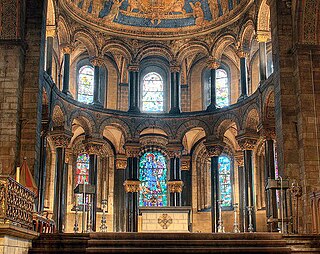
Mosan art is a regional style of art from the valley of the Meuse in present-day Belgium, the Netherlands, and Germany. Although in a broader sense the term applies to art from this region from all periods, it generally refers to Romanesque art, with Mosan Romanesque architecture, stone carving, metalwork, enamelling and manuscript illumination reaching a high level of development during the 11th, 12th and 13th centuries.
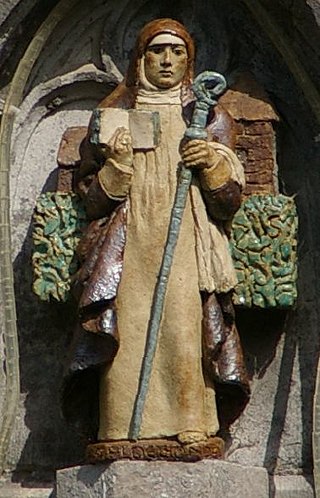
Aldegund, also Aldegundis or Aldegonde, was a Frankish Benedictine abbess who is honored as a saint by the Roman Catholic Church in France and by the Orthodox Church.

Saint Ghislain was a confessor and anchorite in Belgium. He died at the town named after him, Saint-Ghislain.

Saint Pharaildis or Pharailde is an 8th-century Belgian virgin and patron saint of Ghent. Her dates are imprecise, but she lived to a great age and died on January 5 at ninety.

November 20 - Eastern Orthodox liturgical calendar - November 22

Saint Waltrude is the patron saint of Mons, Belgium, where she is known in French as Sainte Waudru, and of Herentals, Belgium, where she is known in Dutch as Sint-Waldetrudis or -Waltrudis. Both cities boast a large medieval church that bears her name.
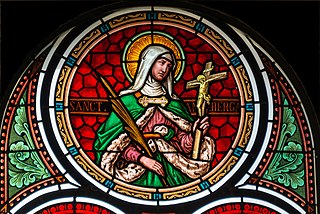
Saint Amalberga of Maubeuge was a Merovingian nun and saint who lived in the 7th century.

Amalberga of Temse was a Lotharingian noblewoman from the Frankish royal house of the Pippinids who is celebrated as a saint in the Roman Catholic Church and the Eastern Orthodox Church. She is especially venerated in Temse, Ghent, Munsterbilzen and other parts of Flanders. She received the veil from Saint Willibrord of Echternach.
Emebert was an early Bishop of Cambrai, often identified with Bishop Ablebert of Cambrai.
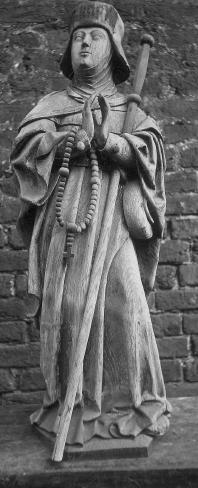
Reineldis was a saint of the 7th century, martyred by the Huns.

Maubeuge Abbey was a women's monastery in Maubeuge, in the County of Hainaut, now northern France, close to the modern border with Belgium. It is best known today as the abbey founded by St. Aldegonde, still a popular figure of devotion in the region. It is thought to have possibly been where the young Jan Gossaert, a Renaissance-era painter known as Jan Mabuse, was educated, claimed by some to have been a native of the town of Maubeuge, which grew up around the abbey.
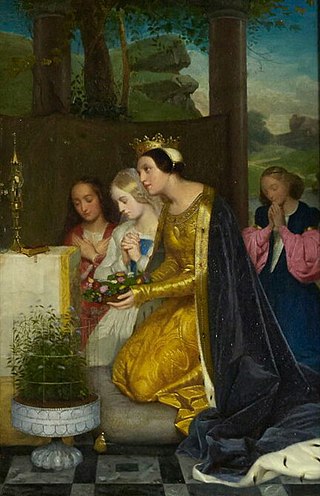
Saint Amelia, Queen of Hungary is an oil painting by Paul Delaroche which was investigated in 2016 by the BBC TV programme Fake or Fortune?
Saint Amelia(Amalberga, Amelberga) may refer to:

Saint Madelberte of Maubeuge was a 7th-century nun related to the Merovingian dynasty. She became abbess of Maubeuge Abbey in the County of Hainaut, now in northern France near the Belgian border. She died in 705 or 706.

The Church of Our Lady is a church in the Belgian municipality of Temse. It is dedicated to the Virgin Mary and its foundation, which is presumed to date to 770, is attributed to Amalberga of Temse.
References
- ↑ "Amalberga von Susteren - Ökumenisches Heiligenlexikon". www.heiligenlexikon.de (in German). Retrieved 2023-06-21.
- ↑ heiligenlexikon.de